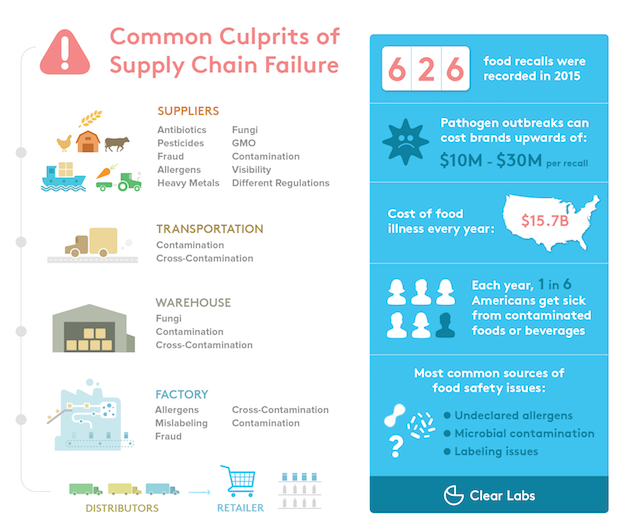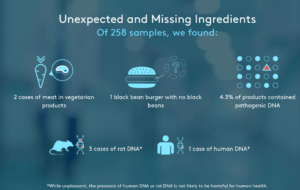Clear Labs: Unwrapping Food Products Through Data and Genomics

The “Google of food” meets DNA testing: through data collection, analytics, and genomics, Clear Labs is trying to create more visibility into our food’s makeup.
Introduction:
Did you know that your black bean burger may contain no beans?[1] Or that your turkey hot dog could contain pork?[2] As a consumer, it is horrifying to know that we may not be able to trust food labels; or worse, that foods may actually make us sick. Using a combination of big data, analytics, and genomics, the food technology startup Clear Labs (which has raised $20M) is trying to de-mystify the makeup of food.
The “Google of Food” [3]
Clear Labs’ greatest asset, the core that powers its business offerings, is its proprietary data set. The company spent two years collecting food samples using next-generation genomic sequencing (NGS) to screen for a variety of characteristics, including authenticity, contamination, gluten, toxic fungi or plants, allergens, the presence of GMOs, and nutritional content. It then indexes these results, along with publicly available data, in a cloud-based platform – according to the company, this is “the world’s largest database of food genetic markers”, with over two million entries and growing.[4] Information on specific products, suppliers, and ingredients are stored as well. The use of NGS is new as it relates to food specifically. However, Clear Labs’ edge is the volume of proprietary data it has collected and the analytical horsepower of its database. With this highly detailed information, the company can perform unique analysis, such as identifying trends around illness outbreaks or connections between ingredients and suppliers.[5]

The Business Model
An analytics platform (“Clear View”) for manufacturers and retailers provides insight into the genetic makeup of food in their supply chain, flags anomalies or issues, and compares products against industry benchmarks.

At the same time, retailers or manufacturers can send the company product samples to be tested. The lab technicians break down the food into its component DNA “barcodes” and compare them to barcodes in the company’s database. Once a match is found, Clear Labs can identify exactly what is – or is not – in the product.[6]
Traditional chemical or GMO testing can be expensive, only test for one attribute at a time, and are time consuming.[7][8] In contrast, NGS-based testing is less expensive, screens for multiple characteristics in parallel in each test, and is much faster. [9] There do not appear to be direct competitors that are using NGS technology specifically for food.
Value Creation:
For manufacturers, Clear Labs provides insights into product ingredients and the supply chain that can save money, increase consumer trust, and even lead to product line innovation. By identifying issues early, companies can avoid costly recalls and minimize the risk of mislabeling and fraud.
For distributors and retailers, Clear Labs’ insights can save both money and time spent pulling items in the case of product recalls. They can select the best suppliers and identify marketplace gaps.
Although not direct customers, with widespread adoption by retailers/manufacturers, consumers can have more confidence in the authenticity and accuracy of their food products and experience safer food consumption.[10]

The company’s revenue model is opaque, but it appears to charge clients for a) sample testing (in a tiered structure based on volume of tests)[11] and b) a subscription for access to its software that could cost “in the low six figures”.[12]
Challenges
Questions around the company’s usage of its data have surfaced in response to company-generated reports that made a splash with their sensational headlines. The company ran three studies investigating the genetic makeup of burgers, hot dogs, and turkey that were purchased in supermarkets and fast food restaurants. The findings were sensational – evidence of human DNA and rat feces? Bogus protein and calorie information?

The company did not release the names of the offending companies, stating that they do not want to be whistleblowers.[13] Yet critics argued that this data should be available for those that the company is trying to, ultimately, protect: the consumer.[14] This leads to the interesting question of to what extent a company with a proprietary, rich data supply has a responsibility to share that information with consumers and regulatory bodies (beyond obvious safety hazards). However, for Clear Labs, to share this data could erode value capture.
Furthermore, while industry adoption numbers are not public, I question the extent to which food manufacturers and suppliers want to know the exact makeup of their food products beyond basic safety information – especially since public pressure would not force them to change their practices. Technology adoption would require, presumably, large budgets, buy-in, and behavior change. To take action based on Clear View’s analytics – changing a supplier, modifying a product line – would be a major undertaking.
[1] https://www.clearlabs.com/reports/the-hamburger-report
[2] https://www.clearlabs.com/food_reports/2015/the_hotdog_report
[3] https://techcrunch.com/2015/09/15/clear-labs-aims-to-be-google-search-for-gmos-in-our-packaged-food/
[4] http://www.fooddive.com/news/what-a-closer-look-at-the-food-supplys-dna-could-mean/405680/
[5] https://www.clearlabs.com/product
[6] https://www.wired.com/2015/09/company-using-dna-sniff-contaminated-food/
[7] http://www.takepart.com/article/2015/09/17/dna-sequencing-food-testing
[8] https://techcrunch.com/2015/09/15/clear-labs-aims-to-be-google-search-for-gmos-in-our-packaged-food/
[9] https://foodtechconnect.com/2016/05/23/dna-sequencing-big-data-food-recalls-safety-clear-labs/
[10] https://foodtechconnect.com/2016/05/23/dna-sequencing-big-data-food-recalls-safety-clear-labs/
[11] https://foodsafetytech.com/news_article/next-generation-sequencing-targets-gmos/
[12] http://www.takepart.com/article/2015/09/17/dna-sequencing-food-testing
[13] https://www.nytimes.com/2015/11/06/nytnow/no-hot-dogs-do-not-contain-human-meat.html?_r=0
[14] http://www.takepart.com/article/2015/09/17/dna-sequencing-food-testing



Julia – this is a great article! As someone conscious of what goes into my food, I would personally be a fan of using something like this frequently. You mention in your post that they aren’t interested in going DTC right now, and I’m curious to know whether you think there is merit to doing a B2C strategy? For example, I wonder if, by going DTC, they can begin to collect more data and conduct pattern recognition so that they can glean insights on food consumption in certain areas or among certain groups. It feels like that data in turn could be pretty powerful for food companies, who might see them as more of a partner than a detractor. Either way, I love that this product exists and hope it brings up food standards for us all!
Julia – I love this company! Your blog post reminds me of a video I watched about how inaccurate calorie counts are (https://www.youtube.com/watch?v=HGunZpKLb5o). There are legal requirements for companies to label the nutritional content of their food but there’s no verification around the numbers they come up with – how crazy is that?!
I wonder if one day, all food companies will be required to use a Clear Labs or similar to verify their numbers. This would certainly bring a lot more data into the space and hopefully bring down the costs and further improve accuracy of the Clear Labs process.
Great post Julia! The sensational headlines are horrifying and definitely got my attention!
I can see real value for food manufacturers to ensure that their food is safe going out the door rather than having to recall a product after it has hit the market. Companies could avoid both monetary as well as reputation risks of the recall. For a food manufacturer to catch contamination or other product issues, I feel like it would need to send in a test of each batch of supplies as they come into their plants. To the extent that you know, how quick is the turnaround for these tests and can the tests be done on site as to not disrupt the product process and timing?
Great, post Julia! I wonder if there’s any information around testing accuracy for NGS. When it comes to genetic testing in criminal justice situations, the chances of DNA contamination are quite high. Has Clear Labs released any information around this? I also wonder how proprietary their technology and data really are. What is their patent strategy? I get the sense that anyone familiar with the application of NGS in other verticals could easily start testing food samples and build their own food database.
Like Ellen, I think that there could be a lot to be gained here from a consumer facing strategy; even if they weren’t able to monetize it directly, it seems like they could choose a few niches to dominate in terms of consumer information, stamp of approval, etc., that would really cement the advantage that their data has already given them. I wonder if there is a Trojan Horse strategy to get funding from companies to build out the database, then flip to a B2C model? Seems that as long as they remain enterprise focused, they have a difficult tightrope to walk in terms of both doing their job and keeping companies happy.